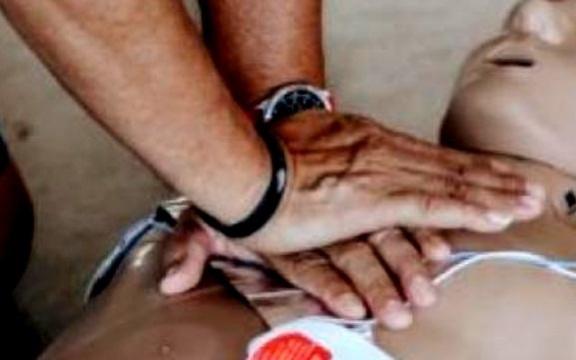The life-saving cardiopulmonary resuscitation, or CPR procedure must not be confined to doctors, nurses and paramedics, but should be imparted to one and all, suggest cardiologists.
CPR is a life-saving procedure used when a person's heart has stopped beating or their breathing has stopped in an emergency.
Amid rising incidence of death due to sudden cardiac arrest (SCA), especially in the young population, a recent study showed that the survival rate currently stands at 1.05 per cent in India, which is dependent on the availability of emergency medical services, prompt bystander CPR, and access to defibrillation.
However, just 2 per cent of the general population in India are aware of how to perform CPR -- far lower than the international average of 30 per cent, according to the Cardiological Society of India
If CPR is administered within 3 minutes of cardiac arrest, it increases the odds of survival, Dr Arun Kumar Gupta, Associate Director -Interventional cardiology, Max Hospital, Gurugram, told IANS.

"CPR should not be confined to doctors, nurses and paramedics, but in fact should be imparted to one and all. CPR techniques should be taught to school kids, policemen, firemen, social workers, gym guides and the list is endless," Dr. Khusrav Bajan, Consultant - Physician & Intensivist, Department of Medicine and Critical Care, P. D. Hinduja Hospital & MRC, Mahim, told IANS.
When should CPR be typically performed?
"CPR is performed when a person is in cardiac arrest in which the heart stops pumping blood to vital organs like the brain," Dr. Bajan said
"Cardiac arrest can be identified when the victim suddenly loses complete consciousness and stops breathing. One must be aware that every minute lost can damage the brain by 10 per cent," he said.
Dr. Bajan also shared that cardiac arrest can be identified by tapping on both shoulders and checking for unresponsiveness and also looking for absent breathing; as well as checking for the pulse of the person.
He said once cardiac arrest is confirmed, one must call for help. An ambulance from a nearby hospital or a common access code such as 108.
How to perform CPR?
CPR has two components, that is chest compression and mouth to mouth breathing, which will help in maintaining circulation to vital organs like the brain and kidney.
"If there is one rescuer at the time of cardiac arrest, then you should only perform chest compression at a speed of 100 compressions per minute. And if there are two rescuers, then one should perform chest compression and the other should perform mouth-to-mouth breathing, with a ratio of 15:2, which means, 15 compressions and two breathing," Dr Gupta explained.
"The CPR performer should now give chest compression on the middle of the breastbone at a rate of at least 100/a min and a depth of 2 to 2.4 inches," Dr. Bajan told IANS.

The doctors called for more aggressive awareness programmes by both public and private sectors involved in healthcare for increasing the understanding of CPR in the Indian population.
"CPR knowledge in the general public has a huge importance since it has the power to save lives in critical situations. Cardiac arrest can happen abruptly and without prior notice.The prompt use of CPR in such circumstances may be the difference between life and death. With this one can save more than 70 per cent of a patient's life, who has sudden cardiac arrest," Dr Gupta told IANS.
(With inputs from IANS)












!['Had denied Housefull franchise as they wanted me to wear a bikini': Tia Bajpai on turning down bold scripts [Exclusive]](https://data1.ibtimes.co.in/en/full/806605/had-denied-housefull-franchise-they-wanted-me-wear-bikini-tia-bajpai-turning-down-bold.png?w=220&h=138)
![Nayanthara and Dhanush ignore each other as they attend wedding amid feud over Nayanthara's Netflix documentary row [Watch]](https://data1.ibtimes.co.in/en/full/806599/nayanthara-dhanush-ignore-each-other-they-attend-wedding-amid-feud-over-nayantharas-netflix.jpg?w=220&h=138)



